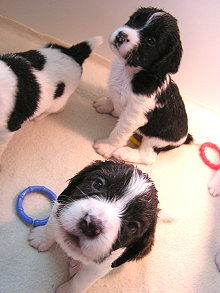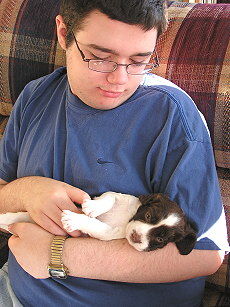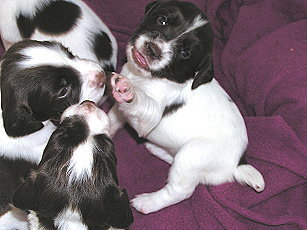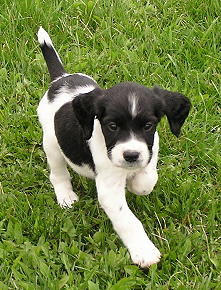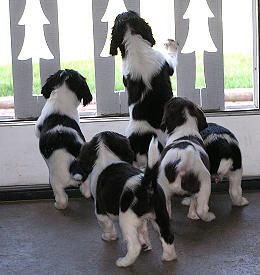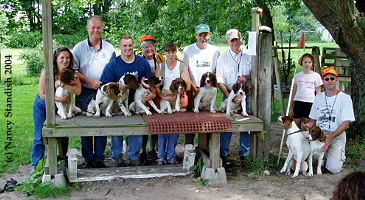aising a litter of puppies can be challenging to say the least. My husband, Hal, and I spend a lot of time preparing our bitches for breeding. We choose good parents with good temperaments and research bloodlines for the perfect stud. We stay up late to help whelp the litter and note each pup as it enters the world. Providing the right food for momma and then for babies when we wean, then we run to the vet for vaccines and eye exams. Prospective buyers are interviewed for our babies.
What else can we do to insure that those pups become great canine citizens? How much of the equation is environmental?
Hal and I believe that it is important to handle the pups as soon as they enter the world. We begin by handling each pup every day, turning them over gently, upside down, around and rubbing their little bodies. If you watch what mom does with them, her interaction is much rougher than our handling. As they grow, openening their ears and eyes, touching techniques are added. The crawling surface of the floor is changed. Gentle noises - like music - are introduced, eventually leading to whistles and the clanging of pots and pans.
Our pups start life in an open whelping box that mom can exit safely. As they begin to really walk well, we “lower the gate”. A light layer of wood chips or sawdust is laid right outside the door. It’s amazing to watch which pups figure out leaving the nest to take their potty break before returning for more sleep or nourishment. Is this the beginning of “housebreaking”?
Weather permitting, we will move them outdoors for short periods of time - gradually extending the length over the next few weeks. We link several of our exercise pens together for the puppies' exercise yard. While we do have a fenced area for the big dogs, we like using this method for the babies, as it allowed us to move the structure to new locations in the yard every few days. This gives pups a new outlook - like changing cover - and new sounds to discover. We add a child’s plastic play set - not too large, but challenging with different sized openings under and through. It supports a slide and a platform. We threw in a rather large cardboard tube for the pups to crawl through. Before long pups will sleep in the tube, or roll each other around.
The beginning of agility?
We believe in giving pups a chance to use their bodies. Soon they will climb the slide, and sleep on the platform or underneath the structure. We place a fairly large box into the pen for them to hide in or push around. A heavy plastic container – big enough to hold water for wading – is a nice attraction in the summer when it’s hot. But not too deep, of course. And we provide plenty of things for them to carry of all shapes and sizes. Plastic milk bottles are good as they have a handle and are not easily destroyed by puppy teeth. The bulk of it gives the pup a challenge. We include soft things like heavy knotted ropes in very short lengths – just enough for pup to carry and to challenge his siblings.
Hal and I raised a litter of nine babies this past spring. I was also lucky enough to have my nieces and nephews - four of them - visit for a week. They gave pups a good work ou, and did the hard job of naming them for me. J Pups were held, jostled, and interacted with for literally hours while the kids were here.
All of these things challenge those pups while they are young - not only physically, but mentally, too. Now, what’s my proof that these techniques did well for these pups? Without fail, each family that took a pup home, called or wrote within the first 24-hours after the pup was home. Some called from their cell phones just 15 minutes after they departed with their new pup to say that pup was already asleep, without a whimper, on their drive home. They were amazed at how well pups adapted to their travel, their new sleeping arrangements, eating habits, and even housebreaking routines.
Just recently, we had a “puppy reunion day”. New puppy owners were invited for a puppy picnic and a learning experience with a chance to meet the other puppy owners. The pups were now five months old. Hal and I had kept the unchosen pup. We helped them evaluate pups at this stage and offered suggestions for expanding the pups training. It was interesting to see how they each interacted with one another. All were very outgoing. No fearful babies cowering in the background. Each took their turns being in the forefront. All but one got in the pond for a swim and a retrieve without reservation. They all interacted with the other puppies and people. After the initial introduction, none exhibited fear in the distracting environment.
We continue to receive emails on the progress of the pups and how happy they seem to be in their new homes. And that was the best part – seeing how happy those pups were – and how nothing seemed to destroy their will to interact with everything going on around them.
One owner bragged that her pup was voted "Miss Congeniality" at the puppy kindergarten obedience class. It was apparent that she had won the crown.
In summary, I believe it is more than just choosing genetics that provides a stable pup. We need to be sure that parents are good citizens. It is important to interact with pups during those first 8-12 weeks on a continual basis. To provide challenges for them physically. It will also help them to develop mentally. And providing an opportunity for new owners to communicate and ask questions. Offering challenging ideas to puppy owners, too - especially while pups are young. It will help keep the youngster on track and socialized – ready for what ever is tossed in their direction.
Raising puppies is a challenge and a commitment. A little ingenuity will go a long way toward producing a happy, healthy attitude in a pup. I am sure this will pay off in future training of the pup.
Thanks for reading.
Cordially, Nancy
|
We would be interested in knowing what techniques others use in socializing their pups. If you have ideas that you would like to share, please email Nancy at:
|
|



